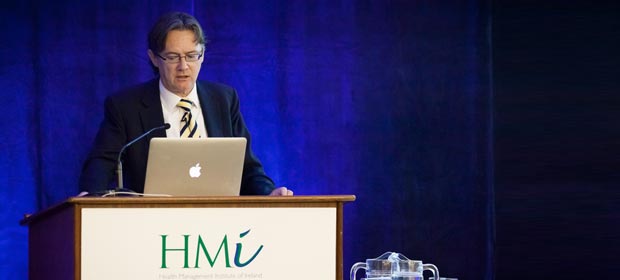His priority was to implement a common integrated financial management system across the HSE, Mr. Tom Byrne, Chief Financial Officer of the HSE told the Conference.
His priority was to implement a common integrated financial management system across the HSE, Mr. Tom Byrne, Chief Financial Officer of the HSE told the Conference.

Speaking on “Financial Reality,” he said that from looking at the reports of the Comptroller and Auditor General, everybody was aware that the HSE’s financial system was not fit for purpose.
The HSE was an amalgam of old Health Boards and there was a vast number of SAP systems around the country and a vast number of finance staff collating data. Across the health service at present about 60 per cent of the time of financial staff was taken up with “ticking and totting,” work that did not add value to what the Executive was trying to achieve. He wanted to release staff from this type of work and support them to bring their expertise into the system.
New financial models were now being developed “We have a once in a life time opportunity at the moment to put in place a financial management system, which if consistently applied across the HSE, will be successful in allowing us to release expert financial people in the system. We could then avail of modern technology to deliver a common business intelligence unit across the system.”
A three year finance development programme, with quarterly milestones, was being implemented and a finance reform office had been established.
He said that since 2008, the HSE had suffered budget reduction of €3.3 bn or 22 per cent, while staffing levels were down by over 11,000 since 2007 and there were further reductions to come. At the same time the demand for the health services continued to rise, due to an ageing population, the recession driven shift away from private insurance and health inflation drivers that caused disproportionate cost increases.
In 2012, hospitals accounted for 31 per cent of health spending
“With that as a base we then look at some of the issues. Current and capital health spend at €13. 3 bn in 2013 is 27 per cent of the total public expenditure.
“In 2012, hospitals accounted for 31 per cent of health spending, the Primary Care Reimbursement system absorbed 19 per cent, the Community Services (including Fair Deal) received 40 per cent , national pensions accounted for five per cent and national services & corporate five percent.
“We need everyone to deliver on their contracts. We must live within our budgets. I cannot argue strongly in Leinster House for what health needs if I get hit back with what hospitals are spending.
“The control of public spending in recent years has had a profound effect on the health services and there has been a fall off in hospital income. A total of €500 million has been taken out of hospitals’ budgets over the last three years.”
Mr. Byrne said it was necessary to deal urgently with income and income collection in hospitals. Prior to his recent visit to one hospital, a consultant had signed off on €500,000 worth of private health insurance claims.
It should be remembered that the health services were doing their bit. “The amount of funding we get has been declining year on year, yet our performance is better, although we may not be reaching the budget targets set for us.”
He said there had been a change in the proportionate funding around health services in the last year. If we continued to drive cost reductions then further reductions might lead to an adverse effect on the quality of service.
He said that if all the financial amounts in the HSE budget earmarked for various purposes such as the Fair Deal (€994 million) and the grants to the 2,000 outside agencies and charities, insurance, heat, light and direct and indirect clinical costs, there was very little room for manoeuvre with the remainder. There was not a lot of room to take out more costs – especially if the HSE had high targets to achieve – without radical surgery around the system.
Mr. Byrne said that the number of adults with chronic conditions was set to increase by 40 per cent by 2020. The amount of money being spent on prescription drugs was extremely high, with pharmaceutical spend 18.5 per cent of total health spend. The difference in the price range between generic and branded products was “beyond belief”. He had just been appointed to chair a review group in this whole area.

